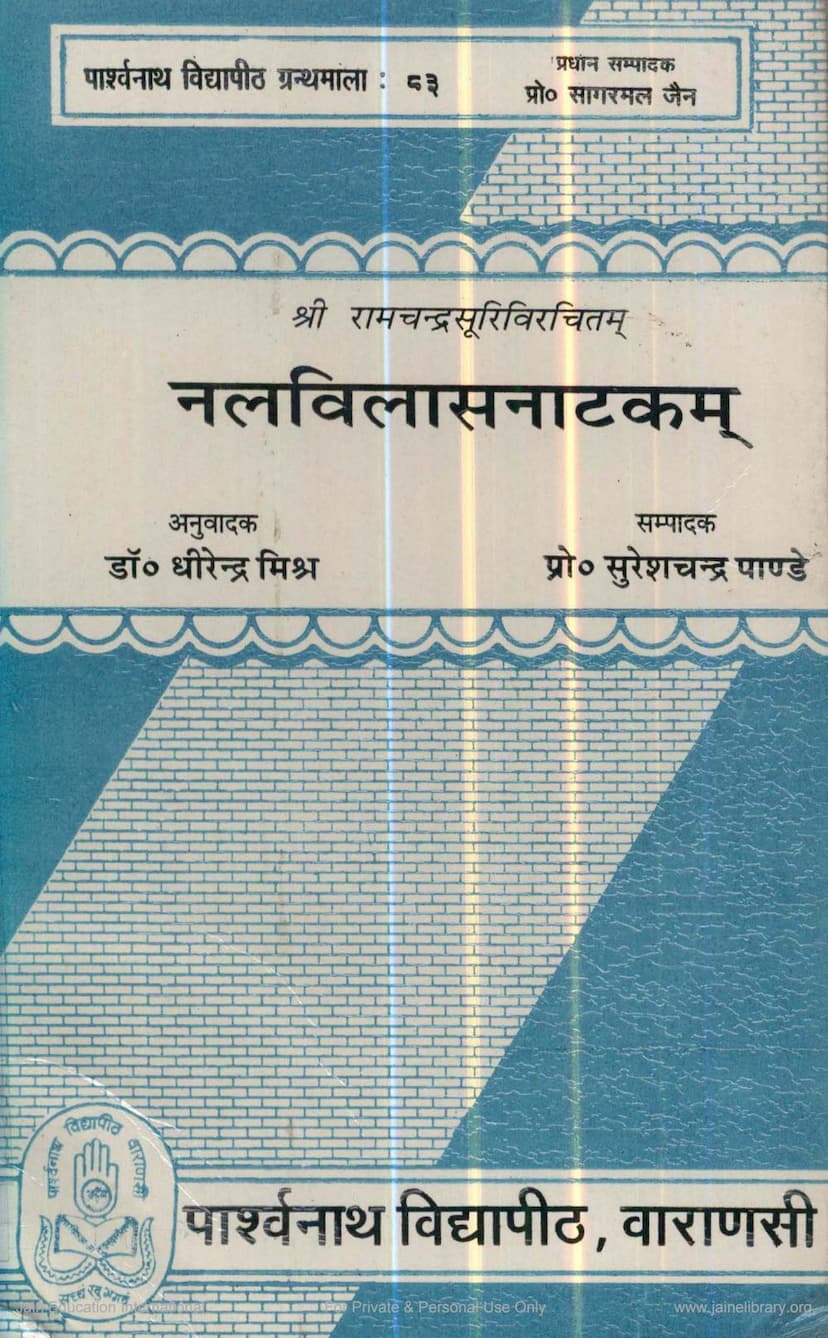Nalvilasnatakam
Added to library: September 2, 2025

Summary
Here's a comprehensive summary of the Jain text "Nalvilasnatakam" by Ramchandrasuri, based on the provided pages.
Book Title: Nalvilasnatakam Author: Ramchandrasuri Publisher: Parshwanath Vidyapith, Varanasi Year of Publication: 1996 Catalog Link: https://jainqq.org/explore/001890/1
This publication is Volume 83 of the Parshwanath Vidyapith Granthamala. It is a Sanskrit drama titled "Nalavilasa" (The Play of Nala) authored by Ramchandrasuri, a prominent disciple of the renowned Jain scholar Hemachandracharya, who lived in the 12th century CE. The work includes a Hindi translation and an extensive introduction by Dr. Dhirendra Mishra, with the overall editing done by Prof. Sureshchandra Pandey.
Summary of the Introduction (Bhumika):
The introduction delves into the significance of dramatic literature (Rupaka/Natya) in Indian tradition, highlighting its role in entertaining and educating the audience. It explains that plays, by imitating human emotions and situations through various forms of acting (Angika, Vachika, Sattvika, Aharya), provide a unique aesthetic experience (Rasa). The text traces the origins of drama back to Vedic hymns and the use of terms like 'Nrtta' and 'Nata.' It emphasizes that Sanskrit dramas, by drawing from epics, Puranas, and poetry, adapt these narratives to suit the tastes and circumstances of the people, making them accessible to both scholars and the general public.
The introduction discusses the theoretical aspects of drama as outlined in texts like Bharata Muni's Natya Shastra and Dhananjaya's Dasharupaka. It defines "Nataka" as a prominent dramatic form that deals with the lives and actions of noble individuals, conveying moral and ethical lessons alongside aesthetic pleasure. It also touches upon the importance of various "Vrittis" (modes of presentation) and "Sandhis" (structural divisions of a play) in creating a cohesive and engaging narrative.
Summary of the "Nala-Damayanti Story" (Mool Katha):
The introduction provides a detailed synopsis of the Nala-Damayanti story as found in the Vanaparva of the Mahabharata. It describes Nala, the virtuous king of Nishadha, and Damayanti, the beautiful princess of Vidarbha. Their love story begins with their mutual admiration expressed through messengers (a swan in the epic's narrative). The story continues through Damayanti's swayamvara (choice of husband), where gods, disguised as Nala, attempt to win her hand, but she ultimately chooses Nala.
The narrative then recounts the hardships faced by Nala due to Kali's influence, leading to his ruin and abandonment of Damayanti. Damayanti's subsequent trials and tribulations in the forest, her encounters with various individuals (including a hunter), her eventual reunion with Nala in disguise (as a charioteer named Bahuka), and their eventual return to their kingdom and restoration of happiness are all summarized.
Ramchandrasuri's Adaptations and Modifications in "Nalvilasnatakam":
The introduction meticulously details the changes and artistic interpolations made by Ramchandrasuri in his play "Nalvilas" compared to the original Mahabharata story. These modifications are driven by dramatic conventions, the pursuit of aesthetic excellence (Rasa), and the portrayal of Nala as a "Dhir-odatta" (noble and dignified) hero. Key changes include:
- Absence of the Swan Episode: The iconic episode of the swan acting as a messenger between Nala and Damayanti is replaced by the appearance of a Kapalika named Lambodara in the royal garden. This Kapalika, in Nala's presence, carries a veiled representation of Damayanti, sparking Nala's interest and desire to know more about her.
- Introduction of Kapalikas and Makrika: The characters of Lambodara, Ghoraghoṇa, and Laba, along with Nala's maidservant Makrika, are introduced to facilitate the plot. Makrika plays a crucial role in conveying messages and arranging Nala's meeting with Damayanti.
- Modification of the Divine Intervention: The gods' desire to marry Damayanti and their sending Nala as an envoy is presented through the Kapalika and his wife Lambastani, who reveal Nala's desire to marry Damayanti and orchestrate a meeting.
- Depiction of Nala's Character: Ramchandrasuri avoids portraying Nala as excessively infatuated or succumbing to vices like gambling in a way that would diminish his noble character. The play focuses on Nala's inherent virtue and his quest for Damayanti.
- Dramatic Presentation of Incidents: Incidents that are described in the epic, like Nala's speech to the birds or his conversations with various characters, are either omitted or re-contextualized for dramatic effect. For instance, the episode of Nala's abandonment of Damayanti is presented through the Kapalika's actions and the subsequent revelation of a 'copy' of Damayanti.
- Emphasis on Rasa and Acting: The introduction highlights that the playwright's aim is to evoke specific emotions (Rasa) and present them effectively through acting, prioritizing dramatic plausibility over strict adherence to the original epic. The inclusion of humor and the emphasis on the "Churṇaka Godya" (a type of prose) contribute to the play's accessibility.
- Character Transformations: Some characters' roles are altered. For example, the Kalhamsa, who was Nala's friend in the original, appears as a companion to Nala, and the role of the messenger is handled by different characters in various stages of the play.
Overall, "Nalvilasnatakam" is a significant Jain adaptation of the popular Nala-Damayanti story, showcasing Ramchandrasuri's skill in blending traditional narratives with dramatic artistry and Jain philosophical nuances. The publication by Parshwanath Vidyapith makes this valuable work accessible to scholars and enthusiasts of Sanskrit drama and Jain literature.